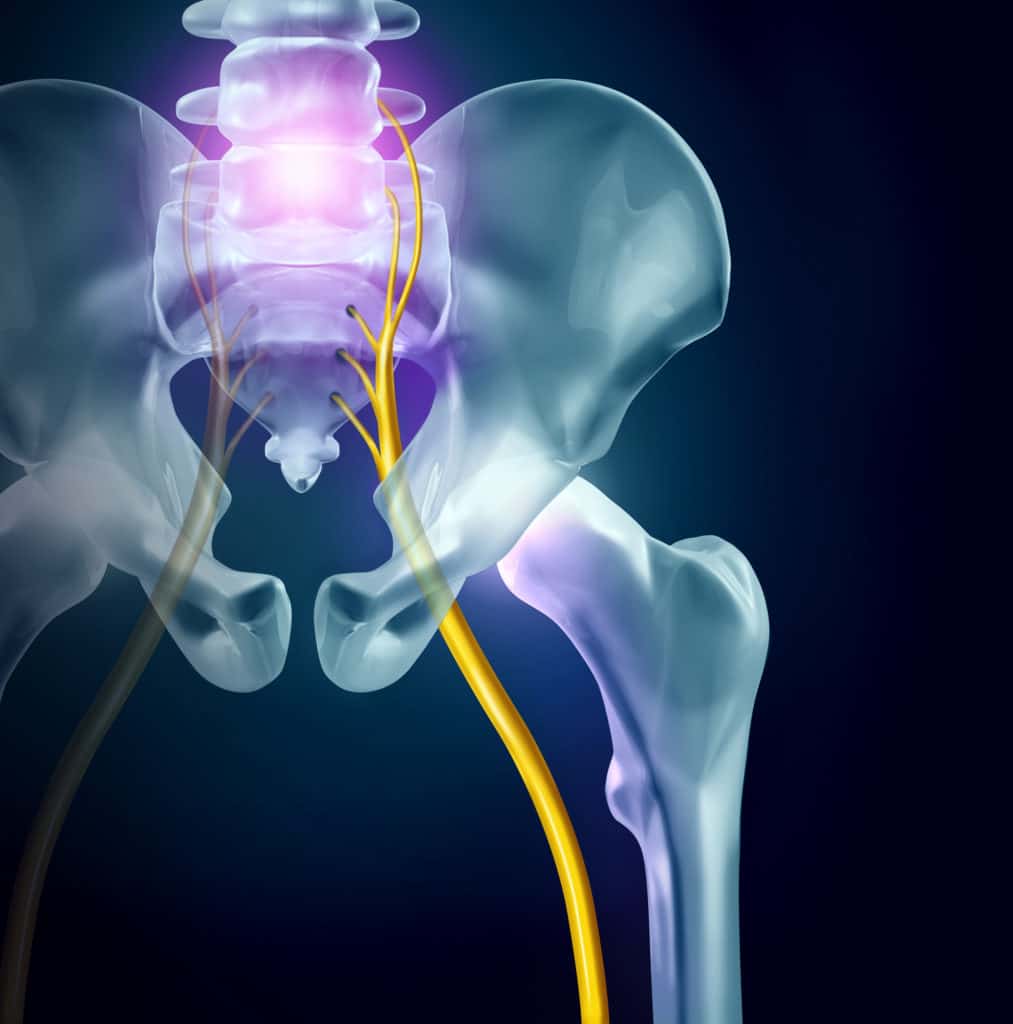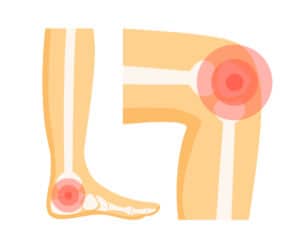
Sciatica is a painful condition that occurs as a result of compression of the sciatic nerve. Several different things can cause this compression. These include but are not limited to disc herniation, spinal stenosis, spondylolisthesis, fractures, or one of the most common causes is pregnancy – due to the additional weight of the baby.
Sciatica is one of the most common pain conditions. The medical name for it is lumbar radiculopathy – or nerve root compression. However, doctors may refer to the underlying cause, such as disc herniation, rather than sciatica itself, which is technically just a set of symptoms.
Sadly, doctors sometimes overlook sciatica. They mistakenly assign the symptoms to straightforward back pain caused by overuse or bad posture. But the tell-tale sign of it being nerve compression and sciatica and not just chronic back pain are that patients usually describe the pain as shooting and radiating down one leg – with pain felt particularly intensely in the buttocks.
But however you want to refer to it, it isn’t very nice. It’s downright miserable.
We hear horror stories every day from patients that have suffered from sciatica and foot and ankle pain for years, even though they’re under the care of their family physician.
Depending on the specific nerves involved, some patients suffer from bladder and bowel problems as a result too. They try powerful medications or nerve block injections, supplements, and exercise routines on YouTube. But nothing seems to work.
The condition does not resolve. Sadly, many people spend years battling the adverse effects of sciatica and foot and ankle pain. Until it feels like the only option left is invasive and potentially dangerous spinal surgery.
When you’re living with sciatica and the associated foot and ankle pain, exercise becomes almost impossible. Even short walks trigger intense pain. You miss social events due to the misery of chronic, daily pain and in lots of cases, patients are forced to take long periods off work.
But it doesn’t have to be that way. You don’t have to go on suffering. It’s true that sciatica probably won’t go away on its own with rest – although in very mild cases, it can do. But you won’t suffer any permanent nerve damage, reduced mobility, or long-term disability either. There are lots we can do to help and, in most cases, fully resolve your symptoms.
The pain will go away – and we can help you avoid it ever coming back again.
You can get back to work, exercise, and play with your kids again.
You can live your life again.
In this blog, we explain the connection between sciatica and foot and ankle pain. We describe the most common symptoms to look out for and give you expert advice on treating both conditions and getting out of pain quickly.
Sciatica + Foot and Ankle Pain: What’s the connection?

After many years of work in this area – helping patients with foot and ankle pain and sciatica, we know that it’s common to experience foot and ankle pain simultaneously with sciatica. But what is sciatica?
Sciatica is a form of nerve pain that affects the area between the hips and knees. You can differentiate nerve pain from other types of pain because it’s usually a combination of tingling, numbness, or burning sensations.
It is usually caused by irritation or “squashing” of the sciatic nerve – the two largest nerves in the human body, which run from your lower back down into each of your legs. You may even feel pain radiating behind your knee.
The pain differs for everyone, but you can feel the pain in any area with nerve endings that travels through or near your sciatic nerves. For example, you’ll most likely have pain in one leg, but it could – in rare circumstances – occur in both legs at the same time. The nerve irritation causes intense discomfort and often pain.
In some cases, it causes numbness or muscle weakness in an area of your leg on one side of your body. Symptoms may also worsen when you are sitting for long periods, climbing stairs, or getting out of bed too quickly.
But How Does Sciatica Translate Into Foot And Ankle Pain?

Well, if your sciatica is mild. You may feel temporary foot and ankle discomfort if you are standing for long periods at work or have to walk for a long distance. However, if more severe back problems – like disc herniation or spinal stenosis are the root cause of your sciatica, it could also lead to more severe foot and ankle symptoms such as swelling, muscle spasms, or an inability to walk correctly.
Sciatic pain often starts in one leg but can then extend to both legs, into the buttocks, and down to the feet and toes. There are numerous causes for this condition, but one of two things usually trigger it: trauma – an accident, illness or surgery, or a mechanical problem in your body like a herniated disk, piriformis syndrome, or pelvic congestion syndrome. It can also be caused by swelling of the spinal cord due to an infection such as Lyme disease.
The primary source of pain may be stabbing or burning in nature and often radiates down one side of the body from the spine. It can cause foot and ankle pain because it affects the nerves that travel down to these areas. Some patients also feel increasing tingling, numbness, or burning sensations when moving around or changing position.
Could sciatica be the cause of your foot and ankle pain?
It’s important to remember that many other conditions can cause foot and ankle pain. Just because you have foot or ankle pain doesn’t necessarily mean that you have sciatica. In some cases, your foot pain might be a fracture or an infection in the foot or ankle joint.
Another condition that could potentially cause foot and ankle pain is arthritis. If you have back, leg, foot, or ankle pain, it’s essential to seek help and get your symptoms evaluated by an expert. Physical Therapy can help you find and treat the root cause, even if it does turn out to be compression of your sciatic nerve (sciatica).
But the more detailed explanation of the connection between sciatica and feet and ankles is that it comes from lower back compression of the sciatic nerves located there. Nerve irritation in this area may cause tingling sensations between toes or a “pins-and-needles” feeling on both sides of your foot. These pain points are where nerve endings are close to the skin surface.
Foot and ankle pain are not always the result of sciatica, but it is a common symptom in the patients we see in the clinic. Sometimes, sciatic nerve irritation can cause significant swelling to appear in the leg, which leads to an increased level of pain and discomfort in the feet when walking or standing.
If you are experiencing symptoms of pain in your feet and calves, as well as numbness or tingling in your legs, it is essential to be evaluated by a Physical Therapist because these symptoms could be signs that you have sciatica.
How To Treat Foot and Ankle Pain Caused by Sciatica

There are many treatments for sciatica, but they fall into two categories: non-operative treatment and surgical treatment.
Non-operative treatments for sciatica include Physical Therapy (the most effective), medications like non-steroid anti-inflammatory drugs (NSAIDs) or opioids, injections, and rest. These treatments are often successful, but you may need to continue with them over some time before your symptoms fully resolve.
As experienced Physical Therapists with a long history of helping patients resolve sciatica and foot and ankle pain – without dangerous surgery, we consider surgical treatments an absolute last resort. With sciatica, there are two main options for surgical intervention:
- Microdiscectomy: This surgery specifically relates to disc herniation. During the surgery, the damaged disc is either partially or entirely removed to relieve pressure on the sciatic nerve. Your surgeon may also need to remove a small piece of bone.
- Laminectomy: During this surgery, your surgeon removes the lamina – the arched part of your spinal bones to make space for your sciatic nerves, or other associated nerves, to pass through without compression or restriction.
We only recommend surgery in very rare cases when patients do not respond to non-operative treatment. These patients continue to have significant leg numbness, pain, weakness, and sensory dysfunction even after physical therapy, rest, and medication.
The most effective way to avoid surgery for sciatica and foot and ankle pain is to consult with a physical therapist as soon as possible. Before any further damage occurs, that might require surgery further down the line.
We help you restore function, reduce or eliminate pain, get you back to exercise, and doing all the things you love to do within a couple of sessions. We find and treat the root cause and help you prevent future reoccurrence with an individualized therapeutic exercise program, and teach you how to move better.











